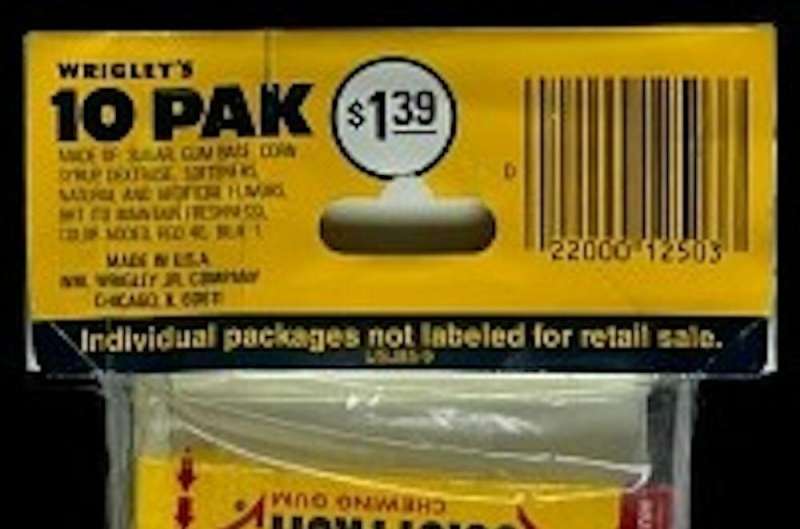This article has been reviewed according to Science X's editorial process and policies. Editors have highlighted the following attributes while ensuring the content's credibility:
fact-checked
trusted source
written by researcher(s)
proofread
Happy 50th birthday to the UPC barcode—no one expected you would revolutionize global commerce

The first modern barcode was scanned 50 years ago this summer—on a 10-pack of chewing gum in a grocery store in Troy, Ohio.
Fifty is ancient for most technologies, but barcodes are still going strong. More than 10 billion barcodes are scanned every day around the world. And newer types of barcode symbols, such as QR codes, have created even more uses for the technology.
I would have been like most people, never giving a second thought to the humble barcode, if my research as a media scholar at Clemson University hadn't taken a few strange turns. Instead, I spent a year of my life digging through the archives and old newspaper articles to learn about the barcode's origins—and eventually went on to write a book about the cultural history of the barcode.
While the barcode didn't herald the end times, as conspiracy theorists once fretted, it did usher in a new age in global commerce.
Barcodes were a grocery-industry invention
While the world has changed a lot since the mid-1970s, the Universal Product Code (UPC)—what most people think of when they hear the word "barcode"—hasn't. The code first scanned on a package of gum on June 26, 1974, is basically identical to the billions of barcodes scanned in stores all over the world today.
When that first UPC code was scanned, it was the culmination of years of planning by the U.S. grocery industry. In the late 1960s, labor costs were rising rapidly in grocery stores and inventory was becoming increasingly difficult to track. Grocery executives hoped the barcode could help them solve both of those problems, and they ended up being right.
In the early 1970s, the industry created a committee that developed the UPC data standard and chose the IBM barcode symbol over a half-dozen alternative designs. Both the data standard and the IBM barcode symbol are still used today.
Based on meeting notes I found in Stony Brook University's Goldberg Archive, the people who developed the UPC system felt they were doing important work. However, they had no idea they were creating something that would long outlive most of them.
Even the grocery industry's optimistic estimates predicted fewer than 10,000 companies would ever use barcodes. As a result, the scanning of the first UPC barcode received little attention at the time.
A few newspapers published short articles about the launch event, but it wasn't exactly front-page news. Its importance was only apparent years later, as barcodes became one of the most successful digital data infrastructures ever.
Barcodes created a shelf-space revolution
Barcodes didn't just change the shopping experience at checkout. By making products machine-readable, they enabled vast improvements to inventory tracking. That meant items that sold well could be restocked quickly when the data indicated, requiring less shelf space to be devoted to any individual product.
As barcode expert Stephen A. Brown has written, that reduced need for shelf space allowed for a rapid proliferation of new products. You can blame barcodes for the fact that your grocery store sells 15 types of almost indistinguishable toothpaste.
Similarly, today's huge grocery stores and superstores likely couldn't exist without the massive amount of inventory data that barcode systems produce. As MIT professor Sanjay Sharma put it, "If barcodes hadn't been invented, the entire layout and architecture of commerce would have been different."
Other industries quickly got on board
The modern barcode was born in the grocery industry, but it wasn't confined to the grocery aisles for long. By the mid-1980s, the success of the UPC system encouraged other industries to adopt barcodes. For example, within a span of three years, Walmart, the Defense Department and the U.S. automotive industry all began using barcodes to track objects in supply chains.
Private shipping companies also adopted barcodes to capture identification data. FedEx and UPS even created their own barcode symbols.
As the sociologist Nigel Thrift explained, by the end of the 1990s, barcodes had become "a crucial element in the history of the new way of the world." They helped enable rapid globalization in ways that would be difficult to imagine if barcodes didn't exist.
Black and white and unnoticed all over
As someone who became so interested in this history that I got a tattoo of my latest book's International Standard Book Number barcode on my arm, the quiet passing of the barcode's 50th anniversary feels almost poetic.
I grew up in a world where barcodes were everywhere. They were on all the products I bought, the concert tickets I scanned, the packages I received.
Like most people, I rarely thought about them, despite—or maybe because of—their ubiquity. It wasn't until I began research for my book that I realized how a barcode on a package of gum set in motion a chain of events that transformed the world.
For decades, barcodes have been a workhorse operating in the background of our lives. Modern humans scan them countless times every day, but we rarely think about them because they're not flashy and just work—most of the time, anyway.
As barcodes keep chugging along in their old age, they're a reminder that the seemingly boring technologies are often far more interesting and consequential than most people realize.
This article is republished from The Conversation under a Creative Commons license. Read the original article.![]()




















